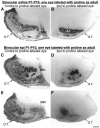Spontaneous retinal activity mediates development of ocular dominance columns and binocular receptive fields in v1
- PMID: 17046688
- PMCID: PMC2647846
- DOI: 10.1016/j.neuron.2006.07.028
Spontaneous retinal activity mediates development of ocular dominance columns and binocular receptive fields in v1
Abstract
The mechanisms that give rise to ocular dominance columns (ODCs) during development are controversial. Early experiments indicated a key role for retinal activity in ODC formation. However, later studies showed that in those early experiments, the retinal activity perturbation was initiated after ODCs had already formed. Moreover, recent studies concluded that early eye removals do not impact ODC segregation. Here we blocked spontaneous retinal activity during the very early stages of ODC development. This permanently disrupted the anatomical organization of ODCs and led to a dramatic increase in receptive field size for binocular cells in primary visual cortex. Our data suggest that early spontaneous retinal activity conveys crucial information about whether thalamocortical axons represent one or the other eye and that this activity mediates binocular competition important for shaping receptive fields in primary visual cortex.
Figures




Comment in
-
Early retinal activity and visual circuit development.Neuron. 2006 Oct 19;52(2):221-2. doi: 10.1016/j.neuron.2006.10.001. Neuron. 2006. PMID: 17046683 Review.
References
Publication types
MeSH terms
Substances
Grants and funding
LinkOut - more resources
Full Text Sources
Research Materials

